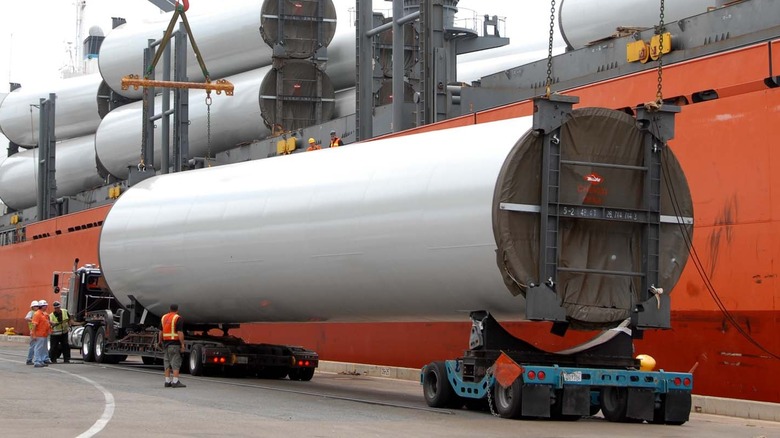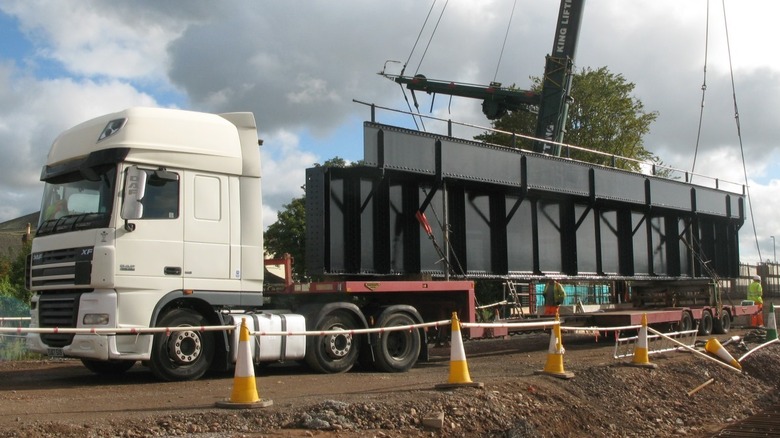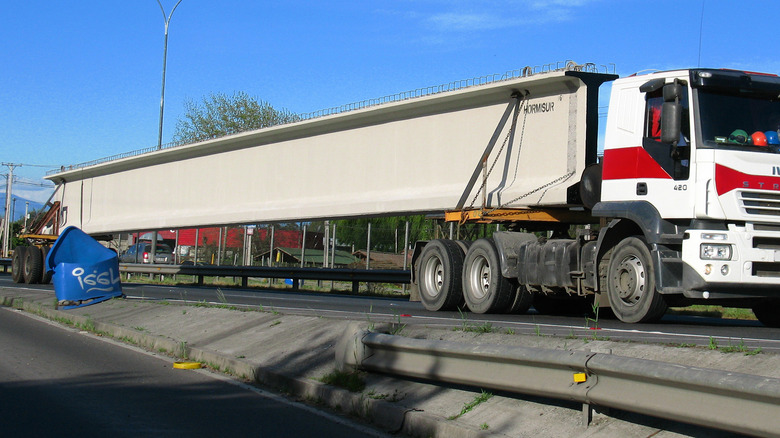
Ever wondered how massive construction structures like a 160-foot-long, 150,000-pound concrete beam or a 100-foot-long wind turbine blade get transported? Well, it looks easy until you are standing next to the behemoth structure and trying to figure out how all the pieces got to the site.
The first thing that'll probably pop into your mind is a helicopter. Unfortunately, the Mil Mi-26, one of the world's heaviest-lifting helicopters, has a maximum external load capacity of 20,000 kilograms, equivalent
to approximately 44,000 pounds. Your best bet is a semi-truck. But how would it get around a tight corner with a 160-foot-long concrete beam? Well, that's where an impressive piece of engineering comes into play - a steer car.
A steer car, also known as a stinger-steered trailer or a jeep, is a support vehicle (manned or remotely controlled) that helps guide the rear of long loads carried by a semi-truck. It controls the rear dolly wheels, allowing the trailer to pivot smoothly around tight corners, turns, and roundabouts where it would otherwise be difficult to clear.
Read more: The Most Reliable Duramax Diesel Engines (And Which To Avoid) According To Owners
How A Steer Car Works And When It Is Used

At first glance, a steer car can look like a second trailer hitched to the back. Simply put, it is a short gooseneck semitrailer with a steerable axle, typically attached to the rear of the main trailer. Depending on the setup, it may include a driver pod, or it may feature a driver pod that's manually operated by a human or controlled remotely.
Think of the steer car as a non-powered tractor that sits at the end of a long load. A steer car normally has three axles, a fifth wheel, and a driver pod (cab). It looks and functions like a conventional truck (without the engine doing the pulling). The driver in the cab steers the front axle of the steer car manually, like they are driving in reverse, but from the back end.
Attached to it is a gooseneck semitrailer. The rear end of the load sits on the swivelling bunk that's mounted on the semitrailer, allowing the load to pivot as needed when making turns. Therefore, as the semi-truck ahead handles the pulling, the steer car at the back keeps the load in check, making sure it follows the road.
Why Steer Cars Matter In Road Safety

There's a lot that happens around construction – it could be a bridge, a ship, or even a rocket. Some components, like turbines, concrete beams, or large tanks, can't be developed on site for one reason or another and have to be transported by a semi-truck thanks to their sheer weight and size. It doesn't matter how large a semi-truck is; they have their own limitations. Depending on the length of the load, it can be challenging to make tight turns. That's where the steer car comes in.
The steer car helps improve road safety, preventing the trailer from overhanging or tipping. Since it helps keep the rear end of the load in check, it prevents the trailer from clipping signs, medians, or other vehicles on the road. Other than preventing damage, steer cars are a legal requirement in the U.S. for superloads (exceeding federal and state limits). They help ensure the truck is road-legal and capable of maneuvering without violating traffic laws or damaging road infrastructure.
Without safety cars, there would be huge traffic snarl-ups and costly delays, especially in cities, considering some superloads would require road closures and detours just to make simple maneuvers. Next time you are on the highway and notice a trailer with a massive load, observe the rear end. The tiny vehicle behind the trailer may be doing more work than you think.
Want the latest in tech and auto trends? Subscribe to our free newsletter for the latest headlines, expert guides, and how-to tips, one email at a time.
Read the original article on SlashGear.











